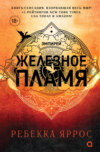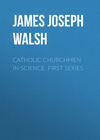Читать книгу: «The Popes and Science», страница 30
Another of the physicians of Pope Clement VIII was Jerome Cordella. While he is highly praised for his knowledge of philosophy and his skill in medicine he is better known for his intimate friendship with St. Philip Neri, of whom Cardinal Newman, in the nineteenth century, was so proud to proclaim himself the spiritual son. Jerome was of assistance to St. Philip particularly in the magnificent social work which meant so much for the correction of social abuses at this time and, above all, the occupation of youthful minds with higher thoughts.
Among Zecchius' books, who was another of the physicians to Pope Clement VIII, is one on "The Means of Curing Especially Such Fevers as Arise from Putrid Humors." Another is called "Medical Consultations or The Whole Practice of Medicine Briefly Treated," a third is on "The Use of Italian Waters," and then besides there are a series of shorter papers on Hippocrates' Aphorisms, on Digestion, on Purgation, on The Letting of Blood, on Critical Days and on the Morbus Gallicus.
Caesalpinus the Botanist.--Caesalpinus is mentioned in the text of the previous edition of this work as a professor at the Papal Medical School, the Sapienza, and physician to Pope Clement VIII. In the history of science, however, he should rather be counted among the botanists than the physicians, though there is no doubt that he was the first fully to describe the systemic circulation. Edward Lee Greene, in his Landmarks of Botanical History, which is "A Study of Certain Epochs in the Development of the Science of Botany" (part of volume 54 of the Smithsonian Miscellaneous Collections, Washington, 1909), mentions that "The Caesalpinus system of plant arrangement seemed incomparably superior to every one that had preceded it." Linnaeus in the warmth of zeal for the great Caesalpino had pronounced him "first in the order of time among real systematists." Caesalpinus is then one of the great founders of modern botany and his work De Plantis is a foundation stone of the science. Gurlt talks of him as the greatest botanist of his century and his work as director of the botanical garden of Pisa did much both for medicine and botany. A little practical work of his was a Manual of the Practice of Medicine, which attracted much attention and is in line with the efforts of Papal Physicians as a rule to make knowledge available for the use of physicians generally.
Still another of the physicians of Pope Clement VIII was Michael Mercatus, an intimate personal friend of the well-known social reformer St. Philip Neri, whose profound influence on the social life of Rome is a matter of history and to whom such men as Newman and Faber and the English Oratorians turned with the loving name of Father in the nineteenth century. Mercatus wrote a series of instructions on the Pest and his medical volume contains also articles on antidotes against poisons, the gout and paralysis. Like many of the physicians of his century he was interested in Oriental problems and wrote a volume on the obelisks of Rome which was published in 1589 and dedicated to Pope Sixtus V. This led to a controversy with Latino Latini during which Mercatus published another volume on the obelisks. Mercatus came of a well-known scholarly family, for his grandfather had been a close friend of Marsilio Ficino and a member of the famous Platonic Academy.
Another of the physicians of Pope Clement VIII, at least he received the honor of the appointment as Papal Physician, though he could not come to Rome to fulfil its duties because of the approach of age, was Nicholas Masinus. He is well known for his work on "The Abuse of Cold Drinks," which was published in 1587. The custom of gathering snow on the mountains and using it in their wine and other drinks during the summer time, which had been practised by the ancient Romans, was revived at the time of the Renaissance and Masinus was sure that it was productive of harm to the digestive system.
Still another of the physicians of Pope Clement VIII who deserves mention was Jacobus Bonaventura, to whom Athenius of Brussels dedicated his edition of the "Medical Consultations of Jerome Mercurialis," calling him "a very distinguished man." He was a particular friend of Mercurialis, who expressed his opinion of him in the highest terms. He made a great many friends among the nobility of Italy and was very dear to the Sovereign Pontiff.
Still another of the physicians of Pope Clement VIII was Julius De Angelis, who came of a well-known academic family with many members distinguished in law and medicine. He was professor at Padua for years and afterwards at the Sapienza in Rome and was chosen by the Pope to give special lessons for the benefit of physicians and medical attendants at the Santo Spirito Hospital in Saxia as it was called. He is mentioned in a number of medical works of the time, and in the book of the Statutes of the College of Physicians of the City of Rome.
Paul V (1605-21).--One of the physicians of Pope Paul V, though at first he had refused the honor because it is said that as an astrologer he had found the stars unfavorable to his acceptance of it, was Pompeius Caimus, from whom we have a number of medical writings. Van der Linden, in De Scriptis Medicis, and others furnish the list of them. He wrote "On Congenital Heat," on "The Indications of Putrid Fevers," on "The Recognition and Cure of Melancholia," on "The Nature of Science and Its Acquisition," "On Grief," a "Treatise on Human Longevity and the Climacteric Years," as well as "Dissertations on the Aphorisms of Hippocrates, Galen and Avicenna," which had been delivered as lectures at Padua, on "The Nature and Differences of Winds," and on "The Early Recognition and the Lengthening of Old Age," besides translating and annotating a number of the works of the old Greek philosophers and physicians in Latin. It may seem strange that a man of such wide erudition and scholarship should still cling to the delusion of astrology, but about this same time Galileo and Kepler were drawing up horoscopes, and in the middle of the eighteenth century Mesmer's astrological essay was accepted for the degree of Doctor of Medicine at the University of Vienna. Caimus, after refusing the chair of medicine at the University of Pisa, to which a magnificent salary was attached, became the physician to Pope Gregory XV.
Gregory XV (1621-23).--Vincentius Crucius was another of the physicians of Pope Gregory XV. He had been a professor at Bologna and we have from him his lectures at Bologna on "Epilepsy or The Comitial Disease," published at Venice in 1603. Books of his "On Catarrh," published at Ravenna, on "The More Frequent Diseases of The Head; Catarrh, Phrenitis, Lethargy and Epilepsy," published at Rome, 1617, and "The More Frequent Diseases of the Chest; Phthisis, Haemoptysis, Asthma, Peri-pneumonia, and Pluritis," issued also at Rome, a volume on "The Diseases of The Stomach" and a series of volumes of Consultations on Medicine, were well known to his contemporaries and to succeeding generations. He wrote besides a commentary on Lucretius, another on Hippocrates, a book on Prophylaxis, a volume on Vesuvius and a popular work in Italian, all his other works having been in Latin, meant to be of assistance to ordinary people in avoiding disease and especially the infectious diseases.
Two of the Papal Physicians of Gregory XV are the brothers Giovanni and Bernardino Castellani. John is the better known and was for years the director of the Hospital of Santo Spirito and received the much coveted title of Roman Citizen for his work for Roman citizens there. He succeeded Elpidiano as lecturer on anatomy and surgery at the University of the Sapienza and left a large anatomical work in manuscript with many copper plate engravings, which were never published. The book of his by which he is known is a volume of directions for venesection from the standpoint of the anatomist. It was the custom then for nearly everyone to have himself let blood several times a year and especially in the spring, somewhat as in our time many people take purgatives. The practices are about equally foolish unless there is some special indication for them. In many families the barber-surgeon was called in almost as regularly for this and with quite as little anxiety about it as for the cutting of the hair. Naturally there had been many mishaps in this practice because the barbers were expert enough but ignorant, and venesection was done from blood vessels all over the body because one patient thought his head ought to be relieved, another his foot, another his chest, and the like. Castellani's book then, called Phylacterium, which I suppose might be translated The Protective, was meant to indicate the anatomical landmarks that should guide the barber-surgeon so as to avoid the danger points. Like so many other of the works of the Papal Physicians it was directed to the correction of popular practices that were the source of injury and suffering to the people. Castellani's book contained directions for the application of cups, dry and wet, which was also a popular practice confided to the barber-surgeons at this time, and like blood-letting had been subject to many abuses.
Urban VIII (1623-44).--One of the scholarly Papal Physicians was Julius Mancinus of Siena, who secured the much coveted position of physician to the Santo Spirito Hospital in Rome by competition. He obtained a great reputation for his ability to make the prognosis of disease and acquired an extensive practice as a consequence. He accumulated a great fortune from his practice but lived very modestly and used his income partly for the education of ambitious youths of talent who were without the means of securing an education and partly in the collection of works of art. He wrote a book on "The Pictures of Rome." A number of books were dedicated to him, and Antonio Recchi in his scientific work expresses his gratitude to him for the help afforded in the collection of plants, animals, and minerals from Mexico.
Two of the Papal Physicians of Pope Urban VIII were the uncle and nephew Sylvester and Thaddeus Collicola. Sylvester taught medicine at the Sapienza and was a very popular teacher mentioned in a number of books of the time. Thaddeus had studied law before taking up medicine, but devoted himself entirely to the second profession and Mandosius speaks of him as "the greatest physician of his time, dear to all the learned men who knew him and to all the good men who were brought in contact with him." Thaddeus was evidently a friend of the literary men of his time, for he is often mentioned by poets and writers. Several books were dedicated to him by scientific and literary admirers.
Innocent X (1644-55).--One of the copious writers among the Papal Physicians was Baldus Baldi, who was the medical attendant of Innocent X. We have a series of books from him, one On Contagious Diseases, a treatise on Hippocrates' Suggestions concerning Air, Water and Habitation, a book On Pleurisy, a detailed account of the fatal illness and the autopsy on the body of Cardinal Bevilacqua and academic lectures on poisons as well as a book on the Opobalsamo Orientate.
A distinguished Papal Physician under Pope Innocent X was Paul Zacchias, "a most learned philosopher and physician who had a very versatile genius and whose deep interest in every form of intellectual work, not only such serious studies as philosophy, medicine, theology and jurisprudence, but also the lighter arts of poetry, music, painting and so forth, made him distinguished among his contemporaries." Zacchias is best known as the author of a book on medico-legal questions which went through a series of editions, was published originally at Rome and afterwards at Lyons in at least two editions there. Zacchias wrote a volume on the keeping of Lent in which he discussed various questions of the relationship of fasting and health, which went through several editions and is often referred to by the moralists. He also wrote a book on Hypochondriasis. Some of his writings that were widely circulated in manuscript are On Sudden and Unexpected Death, On Macules Contracted from the Foetus in Utero, on Rest in the Cure of Disease, on Laughter and Grief, on a Physical Consideration of The Miracles of Holy Scriptures, and other subjects that might be expected to interest a medico-legal expert who was occupied particularly with the psychology of many human problems.
The Papal Physicians were not all Italians, indeed Italian as a national designation was almost unused, men were Neopolitans, Genoese, Venetians, Paduans, Bolognese, Sicilians, Milanese quite as distinctly as now they are French, English, Spanish or whatever else it may be. The Popes usually chose physicians from their own cities but not to the exclusion of others and not a few Papal Physicians were from outside of Italy. Pope Innocent X chose Gabriel Fonseca, a Portuguese, whose father had been a teacher of medicine at Pisa and at Padua, and who himself held chairs in medicine at both of these universities before he was invited to Rome to be a lecturer at the Sapienza and Papal Physician. Van der Linden notes among his writings a work on medical economy, Medici Oeconomia, and a series of lectures on Contagious Fevers, as well as a book on Medical Banquets. Fonseca came to be looked upon as one of the most distinguished teachers of medicine in Italy in his time.
Alexander VII (1655-67).--One of the physicians of Pope Alexander VII was Matthias Naldius, Doctor of Medicine and of Philosophy and a man of great erudition, a scholar in Latin and in Greek, who knew Hebrew, Chaldaic and Arabic. He was sent by the Duke of Etruria on a medical mission of consultation to the Prince of Damascus, who was suffering from what seemed to his attending physicians an incurable disease, and Naldius was able to relieve him. The incident called attention to him all over Italy and he was sent for in consultations to most of the Italian cities. He taught at the medical school of Siena, his birthplace, and wrote a series of volumes on medical subjects. One of these is the rather well-known "Pamphilia or Friendship of the Whole World," the subtitle of which is "The Conciliation of the Opinions of Disagreeing Philosophers." This was published at Siena in 1647 in quarto. He issued a small volume of "Rules for the Cure of Contagious Diseases," Rome, 1656. His great work is the Rei Medicae Prodromi, or introduction to medical science, which has for subtitle "Treatise on the Principal Problems of Physiology."
A distinguished scientist of the seventeenth century who found Rome a refuge and place of opportunity for his studies at this time when beset with difficulties elsewhere, was Borelli, the first to apply mechanical principles to the explanation of physiological problems in his work De Motu Animalium. Borelli had been a professor of science in Messina, visited Florence for a time in order to be with Galileo shortly before the great astronomer's death, accepted the call of the Duke of Tuscany to Pisa, where he had as colleagues Redi and Malpighi, with whom he founded the Accademia del Cimento. He left Pisa, not long after, to return to Messina, whence however he had to flee, having fallen under the suspicion of taking part in a conspiracy against the government, and now found a refuge in Rome. He was pensioned by Queen Christina of Sweden, who was then living in the Papal Capital, but after a time he retired to the monastery of San Pantaleone in Rome, where two years later he died. Professor Foster, in his Lectures on the History of Physiology, which were delivered at a number of universities in this country and subsequently published in the Cambridge Biological Series, devotes a whole lecture, some thirty pages, to "Borelli and the Influence of the New Physics." He does not hesitate to say at the conclusion of the lecture that "when we consider the effect which a perusal of Borelli's book has upon the reader now, we can easily understand how he was the founder of a great school which flourished long after him. He was so successful in his mechanical solutions of physiological problems that many coming after him readily rushed to the conclusion that all such problems could be solved by the same method. And as is often the case the less qualified alike as regards mechanical as well as physiological knowledge and insight to follow in Borelli's path were the men of succeeding times the more loudly did they often proclaim the might of Borelli's method." It has always been thus and doubtless always will be. The smaller men who come after the great masters are quite sure that they can go farther than the master himself and push his system, as did the Darwinians in our time, to silly exaggerations. When the question of the attitude of the Popes to science is under consideration, however, it is well to recall that Borelli's revolutionary work was completed under the aegis of the Popes and a religious order in Rome and the account of it was not actually published in its completed form until after Borelli's death, and then at the expense of ecclesiastics. It is the knowledge of details of this kind that gives us a real insight into the significance of ecclesiastical relations to science.
Innocent XI (1676-89).--The Papal Physician of this Pope was Floridus Salvatorius, to whom the Provost, the Trustees and his Colleagues of the College of Physicians of Rome dedicated, in an Introductory Epistle, a volume of the Statutes of the College of Physicians of the City, in which they praised him very highly. He seems to have been a great favorite with the members of the medical profession in his time at Rome, and other books on medicine were also dedicated to him.
Another of this Pope's physicians was Lancisi, one of the most important in the list, whose place in the history of medicine is pointed out in the body of this book.
Alexander VIII (1689-91).--The physician to this Pope was Romulus Spezioli, doctor of philosophy and of medicine of the University of Firmo, who acquired a great reputation at Rome as physician and finally was selected as Papal Physician. He became professor at the Sapienza, the Roman University, and was very popular as a teacher. After the death of the Pope he gave up his profession of medicine and, like Linacre a century before, became a priest, but his scientific knowledge was taken advantage of to enable him to give lectures on subjects in the borderland between religion and medicine, what has come to be called in our time pastoral medicine, to the theological students at the Roman University, and his medical experience was used in the causes of canonization in order to pass on miracles.
Innocent XII (1691-1700).--Both of the physicians of Innocent XII, Malpighi and Lucas Tozzi, are very well known. Malpighi deserves in medical history a place beside Harvey as one of the greatest of the contributors to the medical sciences and probably even a niche higher than the Englishman because of the number of original observations that he made. I dealt with him earlier in this volume. Lucas Tozzi is the author of a series of books on The Theory and Practice of Medicine that are classics. One of these was issued at Lyons in 1731, another at Paris in 1737, and a commentary on the Aphorisms of Hippocrates at Naples, 1743. He wrote also a commentary on the Ars Medicinalis Galeni, besides smaller contributions to medical theory and practice. One of his books, with the title De Anima Mundi, The Soul of the World, in which he brings together a large number of the fallacies of philosophic writers before his time regarding the universe and man and their origin and destiny, was widely read. He suggests not only how little there is that we know, but how much there is that we think we know that is not so.
Pope Innocent XII died in 1700, and with the beginning of the eighteenth century we feel that we are in our own times. Whatever of direct opposition there has been supposed to be between the Popes and science has always been traced to the older times. It was nearly always shrouded in the mists of medieval history. It does not seem so important then, to follow out the lives of the Papal Physicians in detail in the eighteenth and nineteenth centuries. For anyone who wishes really to know, the information is readily available. There is abundant evidence, moreover, of the favorable attitude of the Popes towards the medical sciences and a number of distinguished men are among their physicians. The great Morgagni, who in his time was undoubtedly the greatest of living physicians, was the intimate friend of a number of Popes and was frequently consulted on all scientific as well as medical matters. Both Pope Benedict XIV (1740-58) and his successor Clement XIII (1758-69) insisted, as we have said in the body of this volume, on having the great pathologist consider the Papal Palace always open to him as a place of residence, whenever he visited Rome. Almost needless to say this same favorable attitude has continued during the nineteenth century.
Pius VI (1775-99).--Among the physicians who treated Pius VI during the severe physical trials of a stormy pontificate was Professor Cotugno of Naples, to whom we owe a number of important discoveries in medicine. He was the first to point out the presence of the cerebro-spinal fluid and ably supplemented the investigations of Valsalva on the ear which did so much to clear up many problems in connection with that organ, most of whose anatomy we owe to Italians. He made a careful study of sciatica, De Ischiada Nervosa, Vienna, 1770, which is the classic foundation of our modern knowledge of that affection. He made a series of post-mortem observations on typhoid fever in which he demonstrated very clearly the intestinal lesions of that affection and came very near solving the important problem of the pathological basis of the disease. Like a number of others about the middle of the eighteenth century, in spite of acute observations on intestinal lesions, he could not get away from the theory of fevers being constitutional and so was unable to separate abdominal typhus from dysentery on the one hand, nor true typhus on the other. The constitutional nature of the disease we have come to recognize to some extent again after the pendulum had swung very far in the direction of the declaration of its local character.
Pius VII (1800-23).--One of the physicians of Pope Pius VII was Professor Giambattista Bomba, who was professor of physiology at the Sapienza or Roman University of that time. One of the surgeons in attendance at the Papal Court was Antonio Baccelli, the father of Professor Guido Baccelli, the distinguished Italian scientist and statesman of the modern time.
Another of the physicians of Pius VII was Flajani, to whom we owe the first description of the affection known as Graves' Disease in English-speaking countries, and often as Basedow's Disease on the Continent, though the English physician Parry anticipated both of these in 1822. Graves' description did not come until 1835, Flajani's had been published in 1802; Basedow did not write the more complete description in which he called attention not only to the goitre and the rapid heart action as his Irish and Italian predecessors had done, but also to the exophthalmos, which is so common an accompaniment, until 1850. Flajani was distinguished for his ability as a clinical observer as his priority in this matter would well suggest.
Gregory XVI (1831-46).--The two of Gregory XVI's physicians who were best known were Professor Paolo Baroni, the distinguished Professor of Surgery, the University of Bologna, and Pier Luigi Valentini, Professor of the Theory and Practice of Medicine at the Roman University. At the conclave which followed his death for the election of his successor, Professor Giusseppe Constantini, the Professor of the Institutes of Surgery at the Roman University, was in attendance. [Footnote 53]
[Footnote 53: When the material of the famous Challenger expedition was being assigned for investigation to those who were expected to use it to the best advantage of science, the diatoms were handed over to the study of Francesco Castracane degli Anteminelli. He discovered in the material submitted to him three new genera of diatoms, 225 new species and some thirty varieties. Altogether he had written some 112 papers on the biology of his favorite microscopic plants. Castracane was a Catholic priest living at Rome in high favor with the ecclesiastical authorities and directly encouraged by the Pope in his work.]
Leo XIII (1878-1903) was so situated in his relations to the Italian government that it would have been almost impossible for him to have selected one of the distinguished professors at the University at Rome, which was, after all, a government institution. His physician then was chosen from distant Ancona and proved to be a man of distinct intellectual capacity, who impressed himself upon the science of Rome in certain ways. This was Dr. Joseph Lapponi, whom those of us who had the privilege of meeting remember with special pleasure. He was professor of practical anthropology at the Academy of the Historico-Juridical Conferences of Rome and the author of a book on "Hypnotism and Spiritism; A Critical and Medical Study," which ran through two or more editions in the original Italian and was translated into several foreign languages. The English edition published by Longmans is well known.
Pius X (1903-14).--Dr. Lapponi continued as the Papal Physician of Leo XIII's successor until his death. Political conditions in Rome having been modified somewhat Professor Marchiafava of the Roman University, now in the hands of the Italian government, became the consultant Papal Physician, the latest of a long line of distinguished men. Marchiafava has done some excellent work with regard to malaria, working out the life cycle of the malarial parasite and demonstrating that the organisms of pernicious malaria and the tertian and quartan malarial fevers are quite different. In recent years Marchiafava has been particularly interested in the pathology of alcoholism, being a prominent factor in that movement in Europe which during our time has made it very clear that alcohol is never a stimulant but only a narcotic and that in practically all cases where it is used regularly, even though not consumed to excess, it produces definite pathological changes in human tissues.
With this list before him, the reader will have all the material necessary to understand the declaration that there is no series of men whose names are connected together by any bond in the history of medicine, even as members of the faculty of our oldest medical schools, that represent so much achievement and original investigation in medical matters as the Papal Physicians. With these men beside them as advisers and very often as intimate friends, it would have been quite impossible for the Popes to have been deliberate opponents of scientific progress. We all know that by a curious irony of fate physicians are sometimes found ranged against the line of advance in medical science, but this is inevitable with human frailty and the incidents of opposition have not done nearly so much harm as their conservative refusal to listen to enthusiastic discoverers, whose discovery was of no significance, has done of good. No medical society in the world has an unblemished record of constant readiness to accept genuine new discoveries and all of them have sometime or other been in opposition to what proved eventually to be significant scientific progress. There are no striking incidents in the lives of the Papal Physicians in this regard though their admiration for Aristotle, Hippocrates and Galen sometimes kept them over conservative. As a rule, however, they were ready to welcome every new step in medical advance that was made.
We all know how much a man's physician usually means in influencing him with regard to the attitude that he shall assume towards scientific advances generally and particularly announced progress in the biological sciences. The Popes could scarcely have had better advisers in this matter than the men who were actually chosen as Papal Physicians. They came from every part of Italy and sometimes even from other countries. A library consisting of their works alone would contain an extremely valuable collection of books illustrating nearly every phase of advance in medicine.
Покупайте книги и получайте бонусы в Литрес, Читай-городе и Буквоеде.
Участвовать в бонусной программе


















